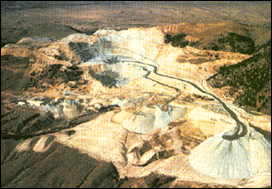The Wild, Wild Mining Law
Will Congress Reauthorize a 19th Century Giveaway?
When President Clinton announced a deal last summer to prevent the New World gold mine from being developed next to Yellowstone National Park, it was widely hailed as an environmental victory. Environmentalists, though, were quick to point out that stopping the mine was only part of the battle. They want Congress to replace the law that made the mine possible in the first place.

The 1872 Mining Law amounts to a virtual giveaway of public land and minerals, with huge environmental costs.
“Yellowstone has been protected through a form of ransom,” says Phil Hocker, executive director of the Mineral Policy Center (MPC), an environmental watchdog organization. “But the kidnapper—the 1872 Mining Law-remains at large.”
The 1872 Mining Law is as simple as the era it emerged from. The law allows mineral exploration and development on most federal public lands and allows mineral claims to be patented, or purchased from the government, for the 19th century price of five dollars an acre. No royalties are assessed on mineral production and, not surprisingly for an 1870s era law, no environmental standards are included.
“Since 1872, the mining law has allowed the sale of $278 billion of gold, silver and other metals,” says MPC's Susan Brackett. The cumulative area of public land sold along with those precious minerals is approximately the size of Connecticut.
This divestiture of publicly owned land and minerals has been accompanied by substantial environmental problems. Hard rock mining creates vast areas of permanent landscape alteration, and roughly 50 billion tons of mining wastes currently remains untreated on public and private lands across the country. To date, mine effluents have contaminated 12,000 miles of American streams and rivers, 180,000 acres of lakes and reservoirs, and untold amounts of ground water.
Critics point to the mining law's lack of environmental standards and clean-up requirements as a major cause of the industry's pollution problems, and they say that the issue needs to be addressed in any revision. The mining industry, however, bristles at the suggestion. “The 1872 Mining Law is an access law, not an environmental law,” argues Ivan Urnovitz, government relations manager with the Northwest Mining Association in Spokane, Washington. “If a company decides to develop a mine, then all other environmental laws apply.” He points out that any mine proposed for federal lands has to meet state and federal environmental laws which, he says, are sufficient to protect the environment.
“The one thing the industry has been consistent on is avoiding responsibility for environmental problems,” says Brackett. MPC points to the roughly half a million abandoned mines across the country, including 66 hard rock mines on the Superfund National Priorities List, as evidence of the law's failure to protect the environment.
MPC advocates comprehensive mining law reform that would include an end to patenting, a 12 percent royalty that would fund an abandoned mine clean-up program, and tough environmental standards and clean-up requirements to prevent future mining pollution.
“Not surpirisingly for 1870s legislation, no environmental standards are included in the Mining Law.”
In 1993, the House of Representatives passed legislation sponsored by Representative Nick Rahall (D-WV) that would have enacted many of the elements favored by MPC. Though the Rahall bill ultimately died in conference committee that year, Congress succeeded in passing a temporary moratorium on mining patents that is keeping 200 mineral claims worth $15.5 billion from being patented.
While the industry has staunchly defended the 1872 Mining Law in the past, the close call with the Rahall bill inspired it to support its own version of reform. A 1995 Senate bill sponsored by Senator Larry Craig (R-ID) sought to change the patenting price to reflect current land market values and institute a five percent royalty on net proceeds of mineral recovery.
Last year, the Republican-led Congress passed Senator Craig's bill as part of an omnibus budget package. The entire budget was eventually vetoed by President Clinton who cited opposition to mining industry giveaways as part of his rationale. Congress will likely be faced with both bills this session, along with a number of other mining reform proposals reflecting the environmentalist and industry positions. Representative Rahall has re-introduced his comprehensive mining reform legislation and Senator Craig is expected to revive his bill later this year. In February, Representative George Miller (D-CA) and Senator Dale Bumpers (D-AR) jointly introduced three separate hard rock mining reform bills that together would eliminate patenting, institute a net royalty fee, fund abandoned mine clean-up and close mining industry tax loopholes.
Environmentalists argue that the “rights” enshrined in the mining law elevate mineral production over all other values on public lands. The gold mine proposed for development on Yellowstone's doorstep would've threatened nearby streams with pollution from mining waste and left toxic wastes perched permanently on the park's border.
Though President Clinton eventually brokered a deal with the mine operators, Battle Mountain Gold of Houston, swapping $65 million in federal land for the mineral rights, the 1872 Mining Law still allows the possibility that other mines may threaten Yellowstone, as well as other public lands. As the 105th Congress considers mining law reform, the echoes of the near miss at Yellowstone may provide the compelling argument Congress needs to finally replace a bad law that's been wreaking environmental havoc for more than a century.

